
Small fruit researchers in the Northwest hope a mulch made from recycled paper pulp will offer a cheaper, less wasteful alternative to the plastic weed mats commonly used in blueberry fields.
Scientists from Washington State University have trials underway on both sides of the state using two forms of the paper slurry.
The research work is in early stages, and scaling would involve logistical hurdles, said Ben Weiss, a master’s degree student at WSU’s Mount Vernon research station in the Northern Puget Sound region. But growers seem open to the idea.
“Hydromulch is very sellable,” said Weiss, who works with small fruits extension specialist Lisa Wasko DeVetter. “People really like the idea of replacing plastics.”
Growers from the Northwest and as far away as New Jersey, the world’s birthplace of blueberry cultivation, have been asking him questions.
Here’s how it works:
Wasko DeVetter and her research colleagues procure two forms of paper mulch. One, a recycled paper with the consistency of newsprint, they call bogus paper. They shred it themselves and mix it with water in buckets, almost like do-it-yourself papier-maché. The other they receive as a slurry from a Wenatchee company that makes fruit packing material.
To both, they add a tackifier product to keep the mulch from falling apart when it rains, though Weiss hopes that step is less necessary in drier Eastern Washington than in northwestern Washington, the state’s two primary blueberry production regions.
In 2022, the research team applied the mulch to trial blocks of strawberry at the Mount Vernon station. This spring, they added a trial in a Yakima Valley commercial blueberry block, as well as a hop field. A mechanic at the research station rigged up a simple applicator using a 55-gallon barrel, a pump and plastic hoses and pipes. At $600, it’s meant only for small-scale applications, Weiss said.

Data so far show the hydromulch suppressed all weeds except thistle and pigweed, Weiss said, and it improved strawberry yield over weed mats, despite reduced early season vigor. The team may experiment with adding colorants to the mixture to warm up soil — as the black plastic does — and promote more vigor. That’s another thing that might be less necessary in Eastern Washington, they said.
Meanwhile, North Dakota State University researchers are running sister trials on strawberries and vegetables using a hydroseeder, an applicator that emits grass seed mixed in a slurry of fertilizers, mulch and water, while researchers at Montana State University have experimented with various mulch recipes. Other researchers at WSU, Oregon State University and the U.S. Department of Agriculture in Minnesota will explore other facets of paper mulch potential.
They all use the moniker MulcH2O as an overarching name for their grant proposals and research documents. The research, funded by a $1.3 million grant from the U.S. Department of Agriculture’s Organic Agriculture Research and Extension Initiative, runs through 2025.
History and potential
Recycled paper mulch has a history in Washington. The MulcH2O researchers partially took the idea from work in apple orchards conducted 20 years ago by David Granatstein of WSU and Gene Hogue, a weed scientist at the Summerland Research and Development Centre in British Columbia.
It took some trial and error. Either paper shreds were too dry and blew away, or the slurry left pinholes for weeds to creep through, but eventually they found formulas that preserved soil moisture, reduced weeds and improved young tree growth in trials in Washington and British Columbia, according to a paper published in 2011.
Granatstein also tried a slurry that improved weed control and soil moisture in sweet corn and other vegetables in greenhouses.
“The stuff worked pretty darn well,” said Granatstein, a professor emeritus of sustainable agriculture.
However, logistical problems with scaling stymied the work. The substance was heavy and difficult to move around. Today, Granatstein suggests trying to mix right at the field border.

As with many agricultural innovations, scaling will be a challenge, Weiss said. Someone will have to invent a bigger applicator, while hauling wet material around the state is expensive. He envisions a system similar to a drip line that could emit the hydromulch — and even pesticides or nutrients at the same time.
Cloud Mountain, a nonprofit organic farm incubator near Bellingham, Washington, has expressed interest in building its own sprayer and teaching other farmers how to use it or build their own, Weiss said.
But the potential sounds intriguing, said Keith Oliver, a farm manager for Olsen Bros. Ranches, a Benton City, Washington, blueberry producer not involved in the trials.
Weed mats make it hard to access soil, he said. A machine lays out the fabric, but the sheets don’t let through much water, especially on the raised berms common in Eastern Washington blueberry fields. To apply fertilizers and other soil amendments, workers must slit the material under the plants and then reconnect it with stakes or clips when done.
Hydromulch could be an easier alternative, he said. “It’s worth looking at.”
—by Ross Courtney







Leave A Comment